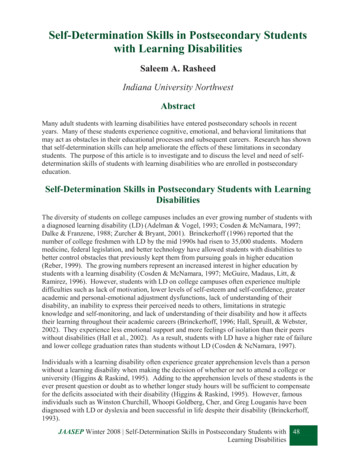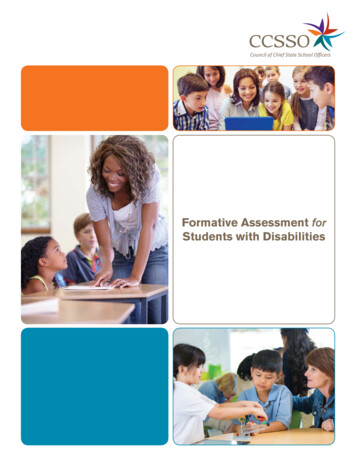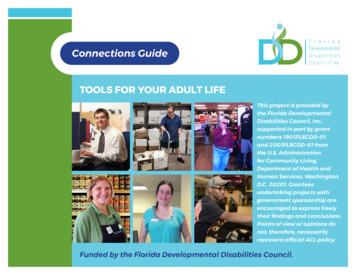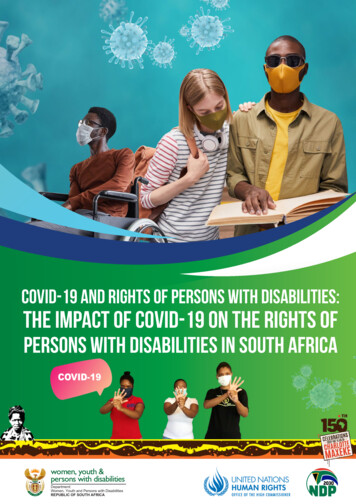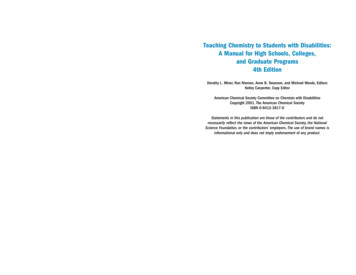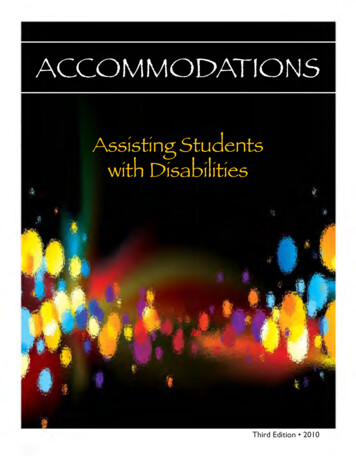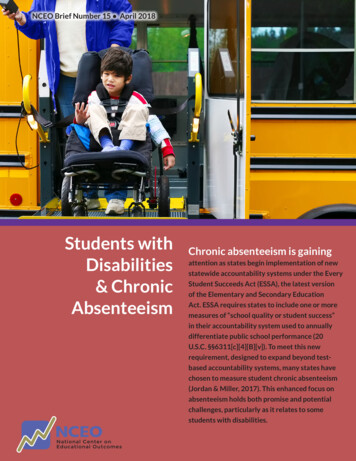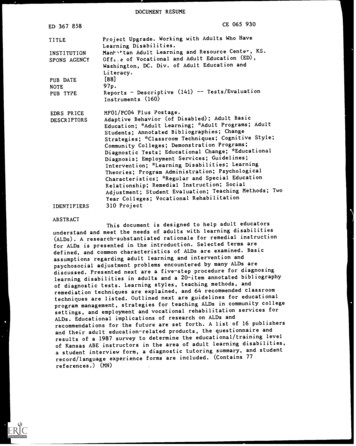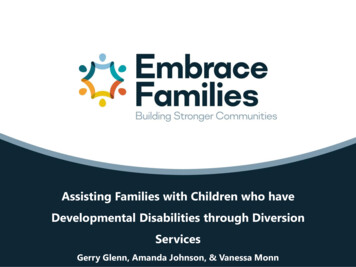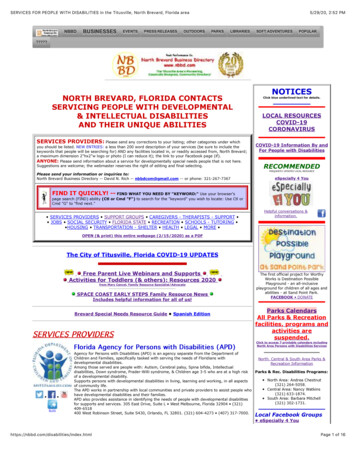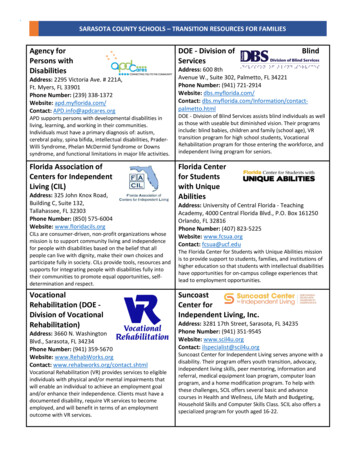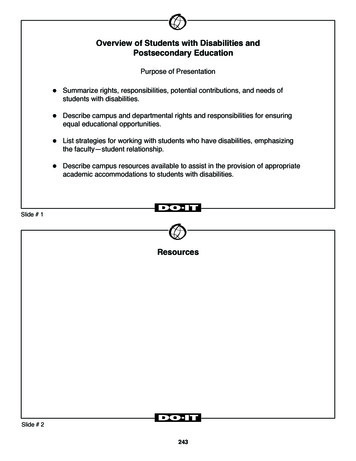
Transcription
Overview of Students with Disabilities andPostsecondary EducationPurpose of PresentationllllSummarize rights, responsibilities, potential contributions, and needs ofstudents with disabilities.Describe campus and departmental rights and responsibilities for ensuringequal educational opportunities.List strategies for working with students who have disabilities, emphasizingthe faculty—student relationship.Describe campus resources available to assist in the provision of appropriateacademic accommodations to students with disabilities.Slide # 1ResourcesSlide # 2243
Visit The Faculty Room website atwww.washington.edu/doit/Faculty/Slide # 3AccommodationStrategiesSlide # 4244
Accommodation Strategies ObjectiveslllllDiscuss the rights, responsibilities, contributions, and needs of students withdisabilities.Summarize campus and departmental rights and responsibilities for ensuringequal educational opportunities.List strategies for working with students who have disabilities.Describe actions that individuals and departments can take to ensure thatstudents with disabilities have education opportunities that are equal to thoseof their non-disabled peers.Describe campus resources.Slide # 5Factors Influencing the Increased Participationof Students with Disabilities inPostsecondary Education:lsurvival rateltechnologylK-12 special educationlawarenessSlide # 6245
Visit the CUDE atwww.washington.edu/doit/CUDE/Slide # 7Section 504 of the Rehabilitation Act of 1973“No otherwise qualified individual with a disability shall, solely byreason of his/her disability, be excluded from the participation in, bedenied the benefits of, or be subjected to discrimination under anyprogram or activity of a public entity.”Slide # 8246
“Otherwise qualified”meets the academic and technical standards requisite to admission orparticipation with or withoutlreasonable modifications to rules, policies, or practices;lremoval of architectural,lcommunication orltransportation barriers; orlprovision of auxiliary aidsland services.Slide # 9“Person with a disability” is any person who:lhas a physical or mental impairment which substantially limits one or moremajor life activities including walking, seeing, hearing, speaking, breathing,learning, and working;lhas a record of such an impairment; orlis regarded as having such an impairment.Slide # 10247
Examples of DisabilitiesLow VisionBlindnessHearing ImpairmentsMobility ImpairmentsMental Health/Psychiatric ImpairmentsHealth ImpairmentsLearning DisabilitiesSlide # 11Accommodations for Low VisionlSeating near front of classlGood lightinglLarge print books, handouts, signs, and equipment labelslTV monitor connected to microscope to enlarge imageslAssignments in electronic formatlSoftware to enlarge screen imageslSoftware to adjust screen colorsSlide # 12248
Accommodations for BlindnesslPrinted materials in electronic formatlDescribe visual aidslAudio, Braille, or electronic notes and textlRaised-line drawings and tactile models of graphic materialslBraille lab signs, equipment labels; auditory lab warning signalslAdaptive equipment (e.g., talking thermometers and calculators; tactile timers)llComputer with optical character reader, voice output, Braille screen displayprinter outputIncreased time on testsSlide # 13Accommodations for Specific Learning DisabilitieslNotetaker and/or audio recorded class sessionslCaptioned videoslTextbooks on tapelVisual, aural, and tactile instructional demonstrationsSlide # 14249
Accommodations for SpecificLearning Disabilities, continuedlCourse and lecture outlineslAssignments given in advancelComputer with speech output, spell checker, and grammar checkerlExtra exam time, quiet testing arrangementsSlide # 15Accommodations for Hearing ImpairmentslInterpreter, real-time captioning, FM system, NotetakerlCaptioned videoslEmaillVisual aids, visual warning system for lab emergencieslWritten assignments, lab instructions, demonstration summarieslRepeat questions and statements from other students during classSlide # 16250
Accommodations for Mobility ImpairmentslNotetaker/lab assistant; group lab assignmentslClassrooms, labs, and field trips in accessible locationslAdjustable table, equipment located within reachlExtra exam time, alternative testing arrangementslAccess to online research resourceslClass assignments and materials in electronic formatlComputer with special input device (e.g., speech input, Morse code,alternative keyboards)Slide # 17Accommodations for Health ImpairmentslFlexible attendance requirementslExtra exam time, alternate testing arrangementslNotetakers and/or taped class sessionslAssignments in electronic formatlEmaillInternet accessible services and/or resourcesSlide # 18251
Accommodations for Speech ImpairmentslllListen carefully to what the person is saying; if you don’t understand,ask student to repeatRelax and take as much time as necessary to communicateAsk questions that require short answers or a nod of the head whenappropriatelWritten communicationlEmailSlide # 19Accommodations for Psychiatric DisabilitieslTape recorder, notetakerlPreferential seating near doorlTests, assignments in alternate formatslExtended time for taking testslSeparate, quiet room for testinglReview academic and behavioral expectations in regular meetings with studentSlide # 20252
General Suggestions for Making Classes AccessiblelAdd a statement to the syllabus inviting students who have disabilities todiscuss their accommodation needslSelect materials earlylTalk with the student about accommodation needslHave policies and procedures in placelMake sure facility is accessiblelProvide materials in electronic formatslProvide clear signage in large printlUse alternative methods of administering tests and testing comprehension ofa subjectlUse campus disabled student services as a resourceSlide # 21Four-Step Model1.What does the task/assignment require?2.What physical, sensory, and cognitive skills are needed?3.What components of the task require accommodation?4.What accommodation options exist?Slide # 22253
Four-Step Accommodation ModelBreak it Down!Setting & EquipmentWhat does the task orassignment require?Not: “If I was (blank)” Icouldn’t (blank)!Real or Fictional!What physical, sensory, andcognitive skills are required?Always ask thestudent!Level of Difficulty?What components requireaccommodation?Cost, time, resources,WHY!Check with anExpert!What accommodation optionsexist?Slide # 23Physical, Sensory, & Cognitive Issues and ChallengesPhysical IssuesThink of the required physical aspects of thetask. What will make the environment accessible,keep the student safe, and allow him/her to bean active participant? What equipment must bemanipulated?Sensory IssuesThink of room temperature, noise, fumes, dust,odors, and allergies. Also consider the ability to speakand/or communicate, and the visual aspects of thetask or assignment.Cognitive IssuesWhat memory and communication skills are needed? Whatis the level of complexity of the task.Sensory ChallengesPhysical ChallengesCognitive Challenges1.lift/carry1.vision1.short-term memory2.stamina/endurance2.hearing2.long-term memory3.push/pull3.touch3.task te5.writing6.repetitive tasks6.oral communication6.spelling7.fine motor: pinch/grasp7.temperature7.string of numbers (math)8.fine motor: manipulate/maneuver8.fumes8.paying attention9.gross motor9.external stimuli9.visual, auditory, or kinesthetic learner.10.sit in chair10.lighting10.self-esteem/advocacy issues11.walk/stand11.other11.behavior issues/acting 5.otherSlide # 24254
Narrative Regarding Student and Accommodation Issues:STUDENT ABILITIES PROFILEEquipment: (Lab equipment, computer, manipulatives)Environment: (fumes, odors, dust, temperature, noise, group work)Task / Assignment:Physical ChallengesAccommodations NeededOptions and ResourcesSensory ChallengesAccommodations NeededOptions and ResourcesCognitive ChallengesAccommodations NeededOptions and ResourcesSlide # 25Universal Design ofInstructionSlide # 26255
Universal Design of Instruction Objectives1.Discuss the principles of universal design.2.Apply principles of universal design of instruction to meet a wide range ofstudent learning needs.3.Explain the difference between employing universal design principles tomaximize access and providing academic accommodations for studentswith disabilities.Slide # 27Diversity in Postsecondary InstitutionslEthnic/racial minoritieslEnglish as a second languagelDifferent learning styleslPeople with disabilitiesSlide # 28256
Universal Design “The design of products and environments to be usable by all people, without theneed for adaptation or specialized design.”Center for Universal Design at North Carolina State UniversitySlide # 29Principles of Universal DesignlEquitable uselFlexibility in uselSimple and intuitive uselPerceptible informationlTolerance for errorlLow physical effortlSize and shape for approach useSlide # 30257
Universal Design of Instruction ExamplesllllCreate an environment that respects and values diversity. Put a statement onyour syllabus inviting students to meet with you to discuss disability-relatedaccommodations and other learning needs.Ensure that all classrooms labs and fieldwork are in locations accessible toindividuals with a wide range of physical abilities and disabilities.Use multiple modes to deliver content (including lecture, discussion, hands-onactivities, Internet-based interaction, and fieldwork).Provide printed or Web-based materials which summarize content that isdelivered orally.lFace the class and speak clearly.lUse captioned videotapes.Slide # 31Universal Design of Instruction Examples, continuedlProvide printed materials in electronic format.lUse accessible webpages (text descriptions of graphics).lllProvide printed materials early so that students can prepare to access thematerials in alternate formats.Create printed and web-based materials in simple, consistent formats.Provide effective prompting during an activity and feedback after theassignment is completed.lProvide multiple ways for students to demonstrate knowledge.lMake sure equipment and activities minimize sustained physical effort.Slide # 32258
UDI Can Apply To:lClass climatelPhysical environments/productslDelivery methodslInformation ntlAccommodationSlide # 33Procedures and OutcomesInstructional Procedures:1.Students will use.to acquire the course content.2.I will use.to present course content.Instructional Content:1.Students will describe 2.Students will be able to list 3.Students will demonstrate Slide # 34259
Measuring Instructional Content VersusProcedures1.Evaluation Content:Students will demonstrate their understanding of.2.Testing Procedure:Students will demonstrate their understanding by.Slide # 35Effective Communicationwith Students WhoHave CommunicationDisordersSlide # 36260
Effective Communication Objectives1.Describe the rights and responsibilities, potential contributions, and needsof students with disabilities.2.Summarize campus departmental and rights and responsibilities forensuring equal educational opportunities for all students.3.Describe disabling conditions that can affect communication in courses.4.Discuss strategies for communicating with students who havecommunication disorders.5.Describe campus resources available to assist in the provision ofacademic accommodations.Slide # 37Topics on Effective CommunicationlLegal issueslHearing impairmentslAuditory processing disabilitieslSpeech impairmentslOther disabilitiesSlide # 38261
Students Who Have Difficulty CommunicatingInclude Those Who:lare deaf or hard of hearing;lhave speech impairments;lhave difficulty processing auditory information because of a learning disability;lrequire extensive time or effort to communicate; andluse technical aids (augmentative communication or an assistant).Slide # 39Hearing Impairments FAQslllWhat do the terms “hearing impaired,” “hearing impairments,” “deaf,”and “hard of hearing” mean?What are some of the communication challenges and strategies ofstudents with hearing impairments?Why is the letter “D” in “deaf” sometimes capitalized?Slide # 40262
Auditory Processing Disabilities FAQsllWhy might a student who can hear well still not understand a classlecture?Which activities in class might be difficult for a student who does notprocess spoken language well?Slide # 41Speech Impairments FAQslllWhat are some examples of speech impairments?When a student cannot speak well, what does that mean about his or herability to understand?What academic situations might create challenges for someone who hasdifficulty speaking?Slide # 42263
Speech ImpairmentsFAQs, continuedllIf speech, hearing and auditory processing are normal, why else might astudent have problems communicating in class?What situations could be difficult for a student with communication difficulty?Slide # 43AccommodationslVisual supportlPrinted handoutslAlternative to verbal participationlSelect materials earlylMultiple evaluation methodsSlide # 44264
Accommodations,continuedlSign language and oral interpreterslCaptioned medialReal-time captioninglAmplification, headphones, and assistive listening deviceslNote-takers and copies of notesSlide # 45Accommodations,continuedlVisual aids, visual reinforcements, and visual warning systemslWritten assignments, written exams, written/alternative lab worklEmail and written communicationlCommunication assistance, peer support, and extended timelSeating, pacing, and alternative arrangementsSlide # 46265
Information AccessSlide # 47Information Access Objectives1.Describe ways that information is presented in postsecondary institutions.2.Discuss the challenges each mode of information delivery creates forpeople with different types of disabilities.3.List solutions to the barriers students with disabilities typically face whenobtaining information in academic settings.Slide # 48266
Academic Context of Information AccesslClassroom worklLabslHomeworklLibrarylWeb resourceslDistance learningSlide # 49Information Access Can Be a Challenge For People with:lVisual impairmentslHearing impairmentslMobility ImpairmentslSpeech impairmentslHealth impairmentslEnglish as a second languagelAlternative learning stylesSlide # 50267
Access ChallengeslSpoken wordlPrinted wordlVideo/televised informationlAudio recorded informationlComputer-based informationSlide # 51Access Issues and SolutionsProblemSolutionaccess to computersadaptive technologyaccess toelectronic resourcesuniversal designprinciplesSlide # 52268
Access to Computersfor Students withDisabilitiesSlide # 53Access to Computers Objectives1.Describe the legal rights of students with disabilities as they relate tocomputer access.2.Summarize the issues, needs and concerns of people with disabilities inaccessing electronic resources.3.Describe common types of adaptive technology for students withdisabilities.4.Discuss strategies to plan and implement adaptive technology capabilitiesfor campus computer labs/workstations.Slide # 54269
Success StorieslNhi—low visionlJustin—blindlKatie—hearing impairmentlCrystal—learning disabilitylJeffrey—mobility & speech impairmentlOscar—mobility impairmentSlide # 55Computers Assist People with:llow visionlblindnesslhearing impairmentslspeech impairmentslspecific learning disabilitieslmobility impairmentslhealth impairmentsSlide # 56270
Adaptive TechnologylHardware/softwarelEasy/difficult to uselInexpensive/expensivelGeneric/uniquelStand alone/networkedSlide # 57Access ChallengeslFacilitylComputerlElectronic resourcesSlide # 58271
Making Computing LabsAccessible to EveryoneSlide # 59Making Computer Labs Accessible to Everyone Objectives1.Describe the legal rights of students with disabilities as they relate tocomputer access.2.Tell how universal design principles can be used to develop computerservices that are accessible to all students.3.Discuss steps to be taken to ensure that students with disabilities haveaccess to campus computer labs.Slide # 60272
Make Sure Computer Lab Users Can:lget to the facility and maneuver within it;laccess materials and electronic resources; andlmake use of equipment and software.Slide # 61Adaptive Technology ConsiderationslAdjustable tableslLarge print key labelslScreen enlargement softwarelLarge monitorslSpeech outputlBraille conversionlTrackballs, wrist rests, & keyguardslErgonomic keyboardsSlide # 62273
Universal Design ofWebpagesSlide # 63Universal Design of Webpages Objectives1.List potential barriers to accessing information on web pages for studentswith disabilities.2.Describe the institution’s legal responsibility to ensure access toinformation presented on webpages.3.Describe universal design guidelines for developing accessible webpages.Slide # 64274
Some Internet Visitors:lcannot see graphics.lcannot hear audio.lhave difficulty with unorganized sites.luse older equipment with slow connections.Slide # 65ADA and the Internet“Covered entities that use the Internet for communications regarding theirprograms, goods, or services, must be prepared to offer those communicationsthrough accessible means as well.”—United States Department of Justice (ADA Accessibility,1997)Slide # 66275
Provide Multiple Means of:lrepresentationlexpressionlengagementSlide # 67“The power of the Web is in its universality. Access by everyoneregardless of disability is an essential aspect.”—Tim Berners-Lee, World Wide Web ConsortiumSlide # 68276
Webpage Development Accessibility Options:1.Avoid inaccessible data types and features.2.Create alternative methods/formats.Slide # 69Example of a Web Accessibility Statement“The DO-IT pages form a living document and are regularly updated. We striveto make them universally accessible. You will notice that we minimize the use ofgraphics and photos, and provide descriptions of them when they are included.Video clips are open captioned, providing access to users who can’t hear theaudio. Suggestions for increasing accessibility of these pages are welcome.”Slide # 70277
Test Your Webpages:lllllwith different operating systems and monitors.with different browsers and with audio and graphics-loadingfeatures turned off.with a text browser.with an accessibility testing program(e.g., Bobby).by accessing the keyboard alone.Slide # 71Policy GuidelineslDisseminate informationlTrainlSupportlEnforce or rewardlEvaluate and reviseSlide # 72278
Universal Design ofDistance LearningSlide # 73Universal Design of Distance Learning Objectives1.List potential barriers to distance learning courses for students withdisabilities.2.Describe faculty, staff, and institutional roles and responsibilities forensuring equal access to distance learning courses.3.Discuss universal design guidelines for developing accessible distancelearning courses.Slide # 74279
Distance Learning in Postsecondary EducationWhat policy, administrative, and technical challenges exist for assuring that ourdistance learning courses are accessible to people who have disabilities?Slide # 75AccommodationVersusUniversal DesignSlide # 76280
Distance Learning ToolslEmaillReal-time “Chat”lWebpageslTeleconferencinglPrinted MaterialslVideosSlide # 77Science, Technology,Engineering, &Mathematics AccessSlide # 78281
Science, Technology, Engineering, & Mathematics AccessObjectives1.Discuss the challenges students with disabilities face in gaining anddemonstrating knowledge in science, mathematics and engineeringclasses.2.List examples of accommodations for students with various types ofdisabilities in science, engineering, and mathematics courses.3.Describe a process for selecting appropriate accommodations.Slide # 79Challenges for Students with Disabilities:lgaining knowledgeldemonstrating knowledgeSlide # 80282
AccommodatingStudents with LearningDisabilitiesSlide # 81Accommodating Students with Learning Disabilities Objectives1.Name different types of learning disabilities and how they impact learning,participation, and demonstration of knowledge in class.2.Describe typical accommodation strategies for students with learningdisabilities.3.Discuss how technology can be used to help students with learningdisabilities achieve academic and career success.Slide # 82283
Criteria for Being Diagnosed with a Learning Disability:lhave average or above average intelligence;lshow lack of achievement at age and ability level; andlshow a severe discrepancy between achievement and intelligence.Slide # 83Types of Learning exialNonverbal learning disabilitiesSlide # 84284
AccommodatingStudents withPsychiatric DisabilitiesSlide # 85Accommodating Students withPsychiatric Disabilities Objectives1.List types of psychiatric disabilities postsecondary students may have.2.Describe how mental health issues impact learning.3.Discuss typical accommodations for students who have psychiatricdisabilities.Slide # 86285
Mental IllnessA diagnosable mental disorder causing severe disturbances inthinking, feeling, relating, functional behaviors, and substantiallydiminished capacity for coping with the ordinary demands of life.Slide # 87Psychiatric DisabilitieslDepressionlBipolar Affective Disorder (previously called Manic Depression)lBorderline Personality DisorderlSchizophrenialAnxiety DisordersSlide # 88286
Functional Limitations May Affect AcademicPerformance When Students Have Difficulty:lwith medication side effects.lscreening out environmental stimuli.lsustaining concentration.lmaintaining stamina.lhandling time pressures and multiple tasks.linteracting with others.lresponding to constructive feedback.lresponding to change.lbeing calm under stressful situations.Slide # 89Instructional StrategieslAddress a variety of learning styles (e.g., auditory, visual, kinesthetic,experiential, or combination of styles).lIncorporate experiential learning activities.lBe prepared to set behavioral expectations for all students in your class.lEmbrace diversity to include people with psychiatric disabilities.Slide # 90287
Accommodation the removal of barriersto participationSlide # 91Possible Classroom AccommodationslPreferential seating (e.g., near the door to allow leaving class for breaks).lPrearranged or frequent breaks.lPermit beverages in class.lUse of tape recorder.lAssign a classmate to be a volunteer assistant.lNotetaker or photocopy of student’s notes.lSyllabus and text books available early.lTextbooks and other course materials available in alternative formats.lPersonal and private feedback on academic performance.Slide # 92288
Possible Examination AccommodationslWritten exams changed to oral, dictated, scripted or typed; exams inalternative format: (e.g., portfolio, demonstration, presentation, role-play);multiple choice to essay.lPermit use of computer software programs.lExtended time for test taking.lExams individually proctored, including in the hospital.lExam in a separate, quiet, and non-distracting room.lIncreased frequency of exams.Slide # 93Possible Assignment AccommodationslSubstitute assignments in specific circumstances.lAdvance notice of assignments.lAllow assignments to be handwritten rather than typed (if possible).lWritten assignments in lieu of oral presentations, or vice versa.lAssignments completed in dramatic formats (e.g., demonstration, role-play,sculpture).lAssignment assistance during hospitalization.lExtended time on assignments.Slide # 94289
An accommodation for an individual isNOT “reasonable” if providing it would:llllpose a direct threat to the health or safety of others.result in a substantial change in an essential element of thecurriculum.require a substantial alteration in (education opportunities)service provision.impose an undue financial or administrative action.Slide # 95Visit AccessDL lide # 96290
"Person with a disability" is any person who: has a physical or mental impairment which substantially limits one or more major life activities including walking, seeing, hearing, speaking, breathing, learning, and working; has a record of such an impairment; or is regarded as having such an impairment. l l l Slide # 10
